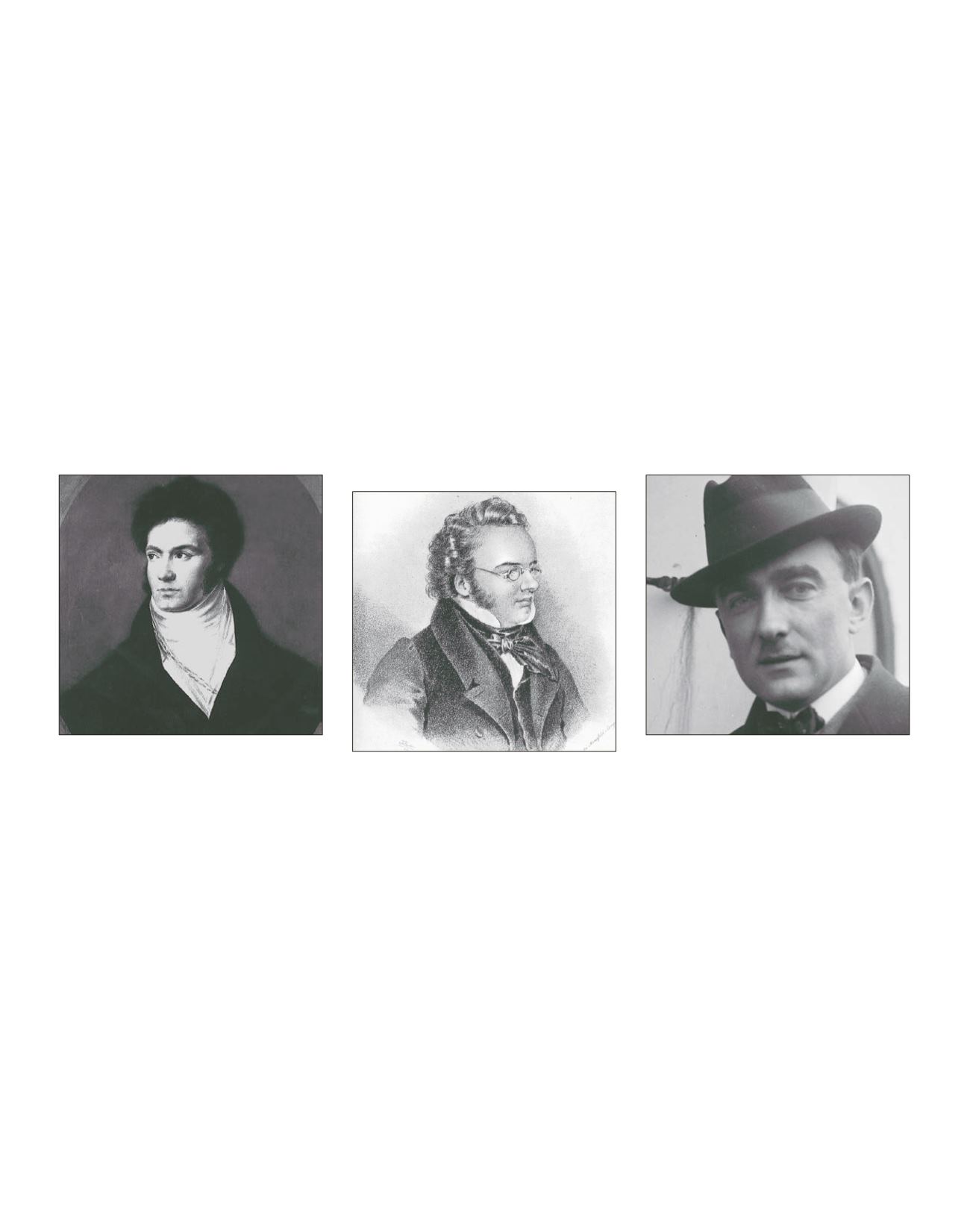
LUDWIG VAN BEETHOVEN (1770–1827)
Piano Sonata No. in A- at major, op.
“Unprejudiced listeners to Beethoven’s music are
less satis ed with his new works for the piano,
in which one perceives a conscious e ort to be
unconventional and original, all too o en at the
expense of beauty. is characteristic, bordering
on the abstruse, is to be found especially in [the
Violin Sonata] op. and in certain movements
of [the Piano Sonata] op.
and [the two Pia-
no Sonatas] op. , though these works do o er
in recompense several brilliant and signi cant
delights.” Already by
, when this critique
was written, the Viennese audience was of two
opinions regarding Beethoven’s music. Lovers
of innovation—broad-minded aristocrats and
progressive musicians—realized the genius
in Beethoven’s “unconventional and original”
ideas.
ose whose tastes re ected the popular
mainstream recoiled from this “conscious” nov-
elty but found great joy in the “brilliant and sig-
ni cant delights.”
e artistic ri continued to
widen into an impassable gulf.
What startled listeners in the Piano Sona-
ta No. in A- at major, op.
(composed in
– , published in
) was the composer’s
deliberate tampering with the logic of sonata
form.
e tried-and-true ordering of move-
ments was not spared the fancies of Beethoven’s
imagination. An
Andante
theme with ve varia-
tions substitutes for the typical sonata-form rst
movement, thus introducing an element of im-
provisation for which Beethoven was so highly
regarded. e middle movements are switched:
a spirited
Scherzo
is succeeded by the mournful
Funeral March on the Death of a Hero
. A rondo
nale seems traditional, but the contrapuntal
writing is unusually involved. To compensate
for the originality of his formal design, Beetho-
ven concocted an extremely simple key scheme:
all four movements are in A- at, either major
or minor. is ingenious work was dedicated to
Prince Karl von Lichnowsky, the bene cent pa-
tron who supported Beethoven during his early
years in Vienna.
In
, while reliving the faded glories of his he-
roic style, Beethoven arranged the slow move-
ment of the op. sonata as a funeral march
for his incidental music to the drama
Leonore
Prohaska
. Twelve years later, the
Funeral March
on the Death of a Hero
, arranged for brass band,
guided the co n bearing Beethoven’s body and
the procession of ,
mourners through the
Alsergasse en route to Trinity Church of the
Minorites.
FRANZ SCHUBERT (1797–1828)
Fantasy in C major, .
(“Wanderer”)
Schubert completed his Fantasy in C major in
November of
, and the music appeared in
a print by the Viennese publisher Cappi & Dia-
belli early the next year as op. . is work was
dedicated to Emanuel Karl, Edler Liebenberg de
Zsittin—a Jewish landowner and piano player
who had studied with Johann Nepomuk Hum-
mel. Karl Maria von Bocklet gave the rst per-
formance of the fantasy at the Vienna Musikv-
erein in
.
At the turn of the th century, the fantasy was a
sectional form whose improvisatory ow of mu-
sical ideas was well suited to the Romantic spirit.
e musical reviewer of the
Wiener Zeitung
, on
February ,
, praised Schubert’s fantasy as
an exemplar of the genre: “ e fantasy has al-
ways been recognized as that kind of musical
piece in which the composer’s art, freed from
the shackles of form, may most clearly unfold
itself and wholly prove its worth. Herr Schubert
has certi ed his master-hand in this latest work,
in which he has shown that he not only possess-
es the gi of invention, but understands how to
develop his felicitous themes according to all
the exigencies of art. e present Fantasy stands
worthily side by side with similar works by the
foremost masters and therefore merits in every
way the attention of all artists and lovers of art.”
Schubert’s Fantasy in C major is divided into
three sections. e rst, marked
Allegro con fuo-
co, ma non troppo,
opens with majestic C-major
chords.
e tempo and key change to
Adagio
and C-sharp minor for the second section. Its
pianissimo
theme—excerpted from Schubert’s
song
Der Wanderer
, .
—gives this work its
nickname. Several variations follow.
e third
section is a
Presto
in A- at major. e C-major
opening music concludes the fantasy.
KAROL SZYMANOWSKI (1882–1937)
Metopes
, op.
e th-century composer Karol Szymanows-
ki occupied a position analogous to Fryderyk
Franciszek Chopin’s one century earlier as the
leading gure of Polish art music.
is stat-
ure proved both an honor and a burden. His
musical language passed through Wagnerian,
Debussyan, and exoticist phases before achiev-
ing a modern nationalistic idiom. World War I,
which awakened a global consciousness while
validating regional (as opposed to imperial) cul-
tural identity, profoundly in uenced this stylis-
tic transformation.
Not long a er the cessation of general military
con ict in Europe, Szymanowski issued a chal-
lenge to his countrymen: “Let us be nationalis-
tic in the cultivation of our ethnic peculiarities,
but let this nationalism aspire without fear to
that state in which its elevated values become
all-embracing. … Let all streams springing from
universal art mingle freely with ours: may they
impregnate, di erentiate, and transform it in
accordance with its particular attributes.” Cho-
pin had succeeded brilliantly in cra ing a “uni-
versally nationalistic” style, and Szymanowski
envisioned a similar path for himself and his
contemporaries.
Szymanowski, though, never intended to be-
come a mere “Chopin imitator,” a conviction that
prompted his general avoidance of folk forms
until the early
s. Instead, his early compo-
sitions explored various styles of musical mod-
ernism, o en with a programmatic or narrative
element, as exempli ed in the three-movement
piano cycle
Metopes
, op. . A
metope
is stone
Ludwig van Beethoven by Isidor Neugass (1806)
Franz Schubert
Karol Szymanowski
RAVINIA MAGAZINE | AUGUST 20 – AUGUST 26, 2018
124








